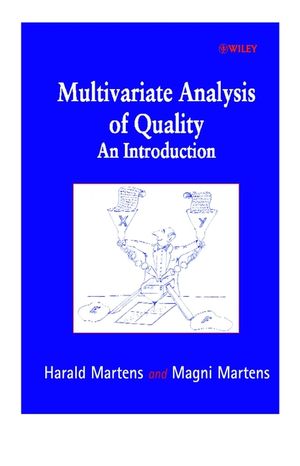Multivariate Analysis of Quality: An IntroductionISBN: 978-0-471-97428-4
Hardcover
468 pages
February 2001
 This is a Print-on-Demand title. It will be printed specifically to fill your order. Please allow an additional 10-15 days delivery time. The book is not returnable.
|
||||||
Preface.
Acknowledgements.
OVERVIEW.
Why Multivariate Data Analysis?
Qualimetrics for Determining Quality.
A Layman's Guide to Multivariate Data Analysis.
METHODOLOGY.
Some Estimation Concepts.
Analysis of One Data Table X: Principle Component Analysis.
Analysis of Two Data Tables X and Y: Partial Least Squares Regression (PLSR).
Example of Multivariate Calibration Project.
Interpretation of Many Types of Data X and Y: Exploring Relationships in Interdisciplinary Data Sets.
Classification and Discrimination X_1, X_2, X_3: Handling Heterogeneous Sample Sets.
Validation X and Y.
Experimental Planning Y and X.
APPLICATIONS.
Multivariate Calibration: Quality Determination of Wheat From High-speed NIR Spectra.
Analysis of Questionnaire Data: What Determines Quality of the Working Environment?
Analysis of a Heterogeneous Sample Set: Predicting Toxicity From Quantum Chemistry.
Multivariate Statistical Process Control: Quality Monitoring of a Sugar Production Process.
Design and Analysis of Controlled Experiments: Reducing Loss of Quality in Stored Food.
Appendix A1: How the Present Book Relates to Some Mathematical Modelling Traditions in Science.
Appendix A2: Sensory Science.
Appendix A3.1: Bi-linear Modelling Has Many Applications.
Appendix A3.2: Common Problems and Pitfalls in Soft Modelling.
Appendix A4: Mathematical Details.
Appendix A5: PCA Details.
Appendix A6: PLS Regression Details.
Appendix A7: Modelling the Unknown.
Appendix A8: Non-linearity and Weighting.
Appendix A9: Classification and Outlier Detection.
Appendix A10: Cross-validation Details.
Appendix A11: Power Estimation Details.
Appendix A12: What Makes NIR Data So Information-rich?
Appendix A13: Consequences of the Working Environment Survey.
Appendix A14: Details of the Molecule Class Models.
Appendix A15: Forecasting the Future.
Appendix A16: Significance Testing with Cross-validation vs. ANOVA.
References.
Index.
Acknowledgements.
OVERVIEW.
Why Multivariate Data Analysis?
Qualimetrics for Determining Quality.
A Layman's Guide to Multivariate Data Analysis.
METHODOLOGY.
Some Estimation Concepts.
Analysis of One Data Table X: Principle Component Analysis.
Analysis of Two Data Tables X and Y: Partial Least Squares Regression (PLSR).
Example of Multivariate Calibration Project.
Interpretation of Many Types of Data X and Y: Exploring Relationships in Interdisciplinary Data Sets.
Classification and Discrimination X_1, X_2, X_3: Handling Heterogeneous Sample Sets.
Validation X and Y.
Experimental Planning Y and X.
APPLICATIONS.
Multivariate Calibration: Quality Determination of Wheat From High-speed NIR Spectra.
Analysis of Questionnaire Data: What Determines Quality of the Working Environment?
Analysis of a Heterogeneous Sample Set: Predicting Toxicity From Quantum Chemistry.
Multivariate Statistical Process Control: Quality Monitoring of a Sugar Production Process.
Design and Analysis of Controlled Experiments: Reducing Loss of Quality in Stored Food.
Appendix A1: How the Present Book Relates to Some Mathematical Modelling Traditions in Science.
Appendix A2: Sensory Science.
Appendix A3.1: Bi-linear Modelling Has Many Applications.
Appendix A3.2: Common Problems and Pitfalls in Soft Modelling.
Appendix A4: Mathematical Details.
Appendix A5: PCA Details.
Appendix A6: PLS Regression Details.
Appendix A7: Modelling the Unknown.
Appendix A8: Non-linearity and Weighting.
Appendix A9: Classification and Outlier Detection.
Appendix A10: Cross-validation Details.
Appendix A11: Power Estimation Details.
Appendix A12: What Makes NIR Data So Information-rich?
Appendix A13: Consequences of the Working Environment Survey.
Appendix A14: Details of the Molecule Class Models.
Appendix A15: Forecasting the Future.
Appendix A16: Significance Testing with Cross-validation vs. ANOVA.
References.
Index.



